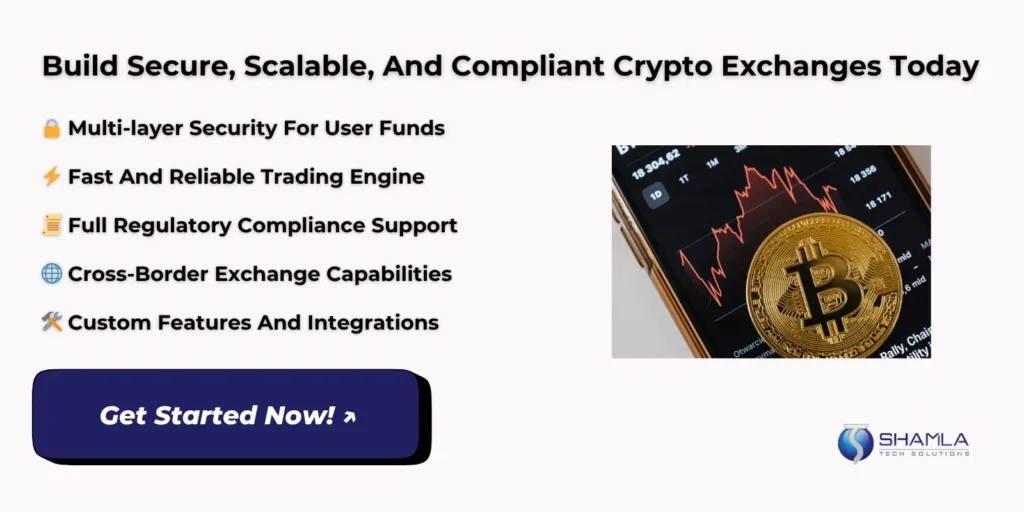The increasing growth of cryptocurrencies has made crypto exchange regulation super essential to be immune from legal risks. Without clear rules, exchanges can face fraud, hacking, and financial losses, putting investors at risk.
Global crypto regulations are now aiming to set clear standards, ensuring exchanges follow safe practices. Legal requirements for crypto exchanges such as proper licensing and security measures are known to help in the maintenance of trust and stability in the market. By enforcing these rules, regulators make sure that digital asset trading is secure, transparent, and reliable, reducing the chance of scams and protecting both the users and the wider financial system.
Crypto Exchange Regulation in 2026
1. Mandatory Licensing for Crypto Exchanges
2. Enhanced Security Standards for Exchanges
3. Integration of DeFi and CEX Oversight
4. Regular Compliance Audits
5. User Data Protection Requirements
6. Cross-Border Regulatory Coordination
7. Transaction Transparency and Reporting
8. Capital and Liquidity Requirements
9. Smart Contract and Platform Audits
10. Enforcement of Penalties for Non-Compliance
Legal Requirements and Licensing for Crypto Exchanges
1. Licensing and Registration Requirements
Exchanges must get formal approval from financial authorities before serving customers. Under Crypto Exchange Regulation, platforms submit business plans, security blueprints, proof of solvency, and governance lists. Regulators inspect custody operations, incident response, access controls, and change logs.
Meeting crypto exchange licensing rules requires policies for withdrawals, key management, data backups, and audits. Successful licensing lowers fraud risk, forces leadership accountability, allows on-site checks, and requires proof of insurance and third-party attestations each quarter and publish compliance reports to regulators.
2. KYC, AML, and Reporting Duties
Exchanges must run identity checks, risk scoring, and transaction monitoring to stop abuse. Regulators list legal requirements for crypto exchanges that include verified onboarding, ongoing screening, sanctions filtering, and timely suspicious activity reports. Platforms must keep exportable ledgers and tax-ready records.
Automated rules and human review must work together. These steps drive cryptocurrency exchange compliance, assign compliance officers, set escalation paths, and require rapid regulator access to data during investigations. Exchanges must run external audits to validate controls each year.
3. Operational Controls and Auditability
Exchanges must separate duties, lock production changes, and require multi-approval deployments. Crypto Exchange Regulation asks for tamper-proof logs, predictable reconciliation, and proof-of-reserves to confirm solvency. Operators must document incident playbooks, run regular restore tests, and keep immutable transaction backups.
These controls support continuous monitoring and let auditors verify source-to-settlement flows. Strong controls force cryptocurrency exchange compliance, shorten resolution times, and reduce silent failures that create large customer losses. Platforms run third-party pentests, publish remediation timelines, and post annual attestation reports.
4. Cross-Border Licensing and Legal Gaps
Exchanges operating across borders must map local rules, obtain multiple approvals, and set localized controls. Different tax treatment, privacy laws, and reporting deadlines complicate operations. Firms must adapt KYC thresholds and store data regionally where required. Matching crypto exchange licensing with local supervision reduces legal friction.
Addressing fragmented rules and legal requirements for crypto exchanges needs joint inspections, shared suspicious-activity feeds, and clear dispute processes to protect users and avoid regulatory fines. Hire local compliance leads and run joint drills.
5. Ongoing Certification and Regulator Reporting
Exchanges must renew approvals regularly through formal checks that include capital reviews, system tests, and governance assessments. Crypto Exchange Regulation sets schedules for filings, incident reports, and capital calculations. Renewals link to crypto exchange licensing status and require transparent remediation of past findings.
Regulators expect fast notification of breaches, proof of reserve reconciliation, and routine stress tests. Continuous reporting and quick fixes keep platforms licensed and reduce the chance of sudden license suspension or heavy fines.
Security Standards and Best Practices in Crypto Exchanges
KYC and AML as First Line Defense
KYC and AML form the first line of defense for exchanges. Under Crypto Exchange Regulation, platforms must verify user identity, run risk screens, and block sanctioned addresses. Automated rules flag strange flows while human teams review alerts.
Strong customer checks reduce laundering and fraud. Implement real-time transaction scoring, clear escalation paths, and keep audit logs. These crypto exchange security standards let regulators trace funds and require prompt incident reports to restore trust and ensure quick customer reimbursements when losses occur.
Custody Design and Key Safety
Exchanges must separate hot and cold wallets and use multi-signature controls to limit single-point failures. Crypto Exchange Regulation pushes proof-of-reserves, third-party custody reviews, and hardware security modules for key storage.
Security in Cryptocurrency Exchanges depends on strict key rotation, threshold signing, and immediate freeze capabilities. Regular backup drills and clear custody chains reduce losses and help legal teams recover assets after breaches while keeping user funds insured and enabling faster cross-border audits globally.
Network and Platform Hardening
Exchanges must run regular penetration tests, code scans, and distributed denial-of-service protections. Crypto Exchange Regulation requires secure deployment pipelines, role-based access control, and encrypted telemetry to prevent insider attacks.
Building a Secure and Scalable Crypto Exchange means automating patching, using autoscaling firewalls, and isolating trading engines. Continuous monitoring, log aggregation, and anomaly detection cut mean-time-to-detect and reduce loss windows during live attacks, improving uptime and user trust. This hardening must be in release checklists and regulator submissions every quarter urgently.
Fraud Detection and Trade Surveillance
Real-time trade surveillance engines detect wash trading, spoofing, and layering by correlating order books, IP data, and chain flows. Exchanges deploy machine rules, statistical models, and investigator workflows to escalate violations. Meeting crypto exchange security standards requires retention of raw feeds, replay capability, and audit trails.
Security in Cryptocurrency Exchanges improves when firms tune thresholds, conduct manual reviews, and share suspicious patterns with other venues to stop coordinated manipulation quickly. Regulators require reports and joint probes to enforce market integrity.
Resilience, Recovery, and Business Continuity
Exchanges must prove disaster plans, run full failover drills, and show recovery time targets for matching service levels. A Secure and Scalable Crypto Exchange design isolates matching engines, replicates order-state across zones, and uses cold backups for keys. Regular restore tests, chain sync checks, and client reconciliation prove operations can resume.
Clear playbooks, communication templates, and pre-funded insurance pools speed customer recovery and satisfy regulator checks aimed at reducing systemic losses and reducing settlement delays for customers.
Global Trends and the Future of Crypto Exchange Regulations
1. Harmonized Licensing And Cross-Border Reporting
Harmonized licensing and reporting standards are now a priority. Under MiCA and FATF pressure, exchanges must get local authorizations, show proof-of-reserves, and meet capital tests. Common data formats for KYC and suspicious-activity reports speed checks across borders.
Crypto Exchange Regulation pushes venues to implement standard APIs for tax and law enforcement. These changes make it easier for firms to operate in multiple markets and reduce legal uncertainty under global crypto regulations.
2. Joint Oversight For DeFi Bridges And Hybrid Services
Regulators now oversee bridges and hybrid services directly. Exchanges that connect on-chain pools to order books must run smart contract audits, oracle checks, and wallet separation. Clear risk disclosures and recovery plans are required.
DeFi and CEX regulations force platforms to cap algorithmic leverage and publish liquidity metrics. This reduces spillover risk between chains and venues, and it makes response coordination with validators, custodians, and law enforcement faster and clearer for everyday operations.
3. Stronger Tax, Trade-Tape And Reporting Demands
Tax and reporting rules expanded worldwide. Exchanges must deliver machine-readable trade tapes, user cost-basis reports, and rapid responses to tax authorities. Platforms build automated reconciliation, exportable audit logs, and identity proofs at scale.
Global crypto regulations push firms to link on- and off-ramps to bank-grade reporting systems. Entrepreneurs learning How to Start a Cryptocurrency Exchange must plan for heavy reporting costs, certified data feeds, and API endpoints that support audits and compliance testing.
4. Security Scorecards Tied To Licensing And Recovery Rules
Security rules now demand proof-of-reserves, multi-party key control, and live regulator feeds. Exchanges must run constant pen tests, publish audit summaries, and enact insured custody limits. Incident playbooks and fast customer reimbursement policies are required.
Crypto Exchange Regulation links license renewal to security scorecards and breach response. Firms that fail must show clear remediation plans. These measures stop major losses, restore confidence, and allow institutional wallets to integrate with exchanges safely.
5. Compliance-First Product Stacks And Vendorization
Innovation is shifting toward compliance-first platforms. Vendors and builders now sell audit-ready stacks, token-listing pipelines, and compliance modules. Buyers often shortlist firms from Top 10 Crypto Exchange Development Companies lists to get preapproved features and faster time-to-market.
DeFi and CEX regulations push developers to include oracles, on-chain controls, and clear token standards. Entrepreneurs use certified vendors, study Top 10 Crypto Exchange Development Companies for blueprints, and adapt to global crypto regulations favoring interoperable, secure stacks and build testnets.
Conclusion
Regulation, licensing, and security are essential for the future of digital assets. Understanding crypto exchange laws ensures that anyone who wants to create a Crypto Exchange, run a Peer-to-Peer Cryptocurrency Exchange, or develop a Hybrid Crypto Exchange safely. A well-managed cryptocurrency exchange platform protects users, prevents fraud, and builds trust in the market.
Shamla Tech is a top Cryptocurrency Exchange development company helping businesses design user-friendly exchanges. They guide clients through legal requirements, implement security standards, and launch platforms successfully, ensuring compliance while maximizing usability and market reach for long-term growth.
Contact Us Today To Launch Your Crypto Exchange With Full Compliance!





